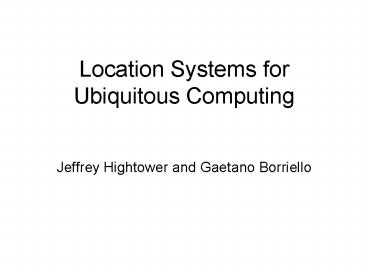Location Systems for Ubiquitous Computing PowerPoint PPT Presentation
1 / 20
Title: Location Systems for Ubiquitous Computing
1
Location Systems for Ubiquitous Computing
- Jeffrey Hightower and Gaetano Borriello
2
Intro
- Ubiquitous computing
- a person wanting to know where he was when he did
a particular task - Help rescue teams
- Customize environment based on location of user
- devices have already been developed
- what they sense and how they go about achieving
it - physical attribute used
- size
- power usage
- type of results obtained
3
Physical Position and Symbolic Location
- Physical
- GPS - 473917 N by 1221823 W
- Symbolic
- Abstract , relative to the position of a known
object - Provide coarse grained location information
- Derived from Physical-positioning systems
- Linking real-time train positions to the
reservation and ticketing database can locate a
person on a train
4
Absolute versus Relative positioning
- Absolute location systems GPS uses a universal
reference grid - Two GPS receivers at the same position will show
the same reading - In Relative Systems, each receiver has its own
frame of reference - Devices that use a particular transmitter form a
grid relative to that transmitter - Absolute position can be transformed to a
relative one relative to another reference
point
5
Localized Location Computation
- Object we are interested in computes its own
location - Ensures privacy
- Does not require the object to transmit
information for external systems to locate it - Burden on the object increases so it is better
left to the external system
6
Accuracy and Precision
- Depend on the distribution of error and the
density of elements - Overlapping levels of positioning systems to
obtain fine grained location information - Coping dynamically with failures
- Suitability for application at hand
7
Scale
- Coverage of system, the number of objects the
system can locate per unit area per unit time - Communication bandwidth is important
- Increasing infrastructure
8
Recognition
- Recognition of located objects to carry out some
action, like controlling the located device over
the internet - Assigning unique IDs to the located objects
- Combine contextual information
9
Limitations
- GPS does not work indoors
- Interference
- Characteristics of underlying technologies
10
- Active Badge
- Active Bat
- Cricket
- RADAR
- Motionstar Magnetic Tracker
- Easy Living
- Smart Floor
- Enhanced 911
11
Active Badge
- Uses diffuse infrared technology - flooding an
area with infra-red light - Each badge emits signal with unique id every 10
seconds that is received by a network of sensors - Location is symbolic restricted area like a
room - Range of several meters
- Has difficulty in presence of sunlight
12
Active Bat
- Infers location based on time of flight of
ultrasound pulse - Each bat emits an ultrasound pulse with unique id
to a grid of receivers - At the same instant a controller resets the
receiver - Orientation is calculated by analysis
- Distance is computed from the time interval
between the reset and receiving the pulse - Accurate to within 3cm
- Paging
- Requires large sensor infrastructure
13
Cricket
- fixed ultrasound emitters and mobile receivers
- time gap to receive the signal is also set in the
pulse to prevent reflected beams - computation takes place at receiver
- decentralized architecture
- few centimeters of accuracy
- computational and power burden
14
RADAR
- Based purely in software, building on standard RF
wireless LAN technology - Uses signal strength and signal to noise ratio
from wireless devices - Employs multiple base stations with overlapping
coverage - Requires wireless LAN support on objects being
tracked - Generalization to multifloored buildings is a
problem
15
Motionstar Magnetic Tracker
- Uses electromagnetic sensing
- Axial DC magnetic-field pulses are generated
- Position and orientation are found from by
measuring the response on the three axes - Less than 1mm spatial resolution and 0.1
orientation - Must be within 1-3 meters of transmitter
- Motion capture for animation
16
Easy Living
- System to keep track of a room's occupants and
devices - Uses real-time 3D cameras to provide vision
positioning - measures location to roughly 10 cm on the ground
plane, and it maintains the identity of people
based on color histograms - Difficult to maintain accuracy
- Aimed for a home environment
17
Smart Floor
- System for identifying people based on their
footstep force profiles - Does not need device or tag
- 93 overall user recognition
- High cost factor
18
Enhanced 911
- Locates any phone that makes a 911 call
- reported in most instances with an accuracy of
100 meters or less - Can be enhanced for use by cell phone users
- Identifying areas of traffic congestion
19
Future Work
- Integrating multiple systems
- Overlapping levels off sensing
- Increases accuracy
- Ad Hoc Location sensing
- Cluster of ad hoc objects
- Relative or absolute
- Correlation of multiple measurements
- High scalability
20
Choosing a System
- Accuracy based comparison
- Representing error distributions
- Evaluation
- Density of elements
- Prototyping using a simulator
- Quake iii

